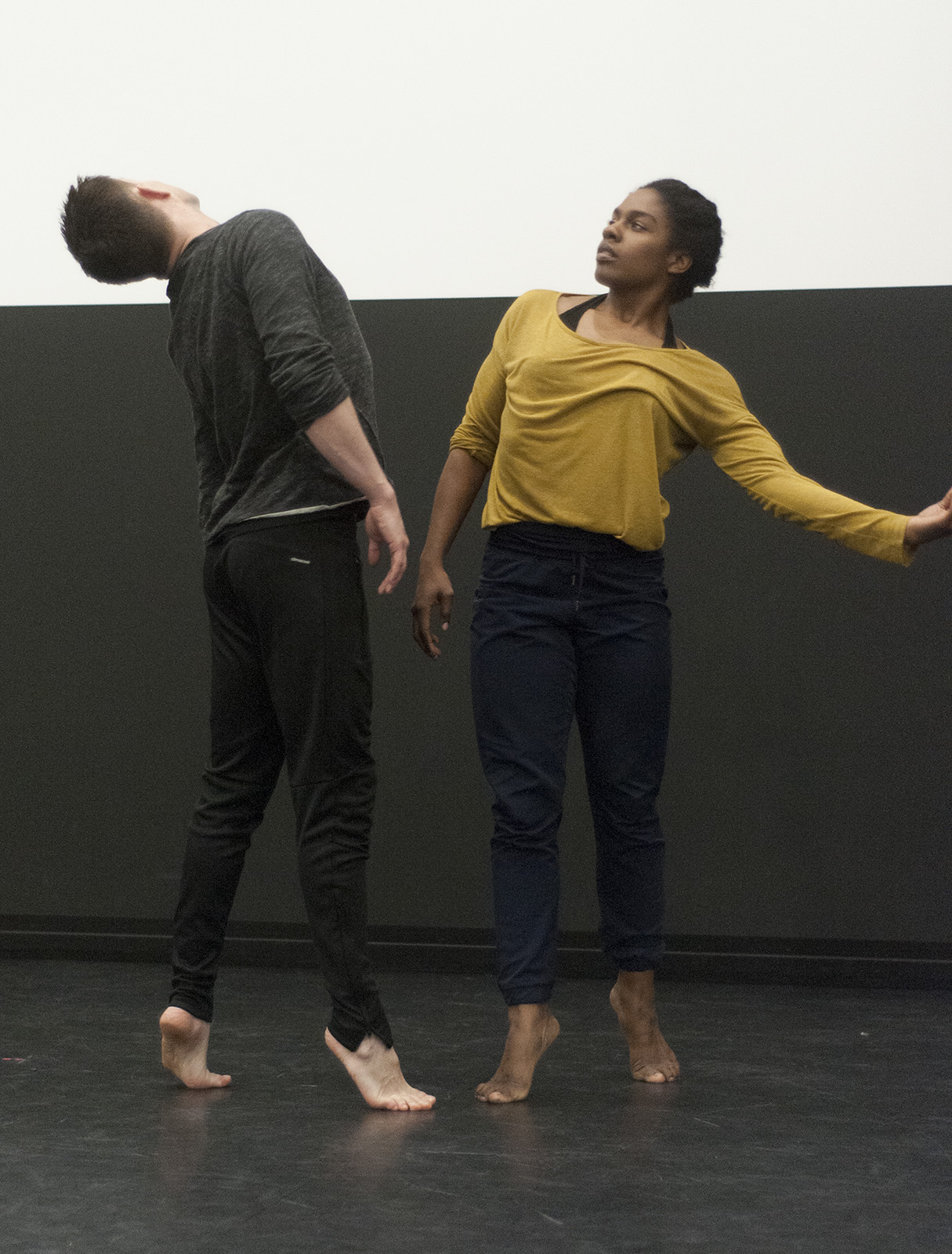‘Dearest Home’ uses nontraditional format to connect to audience

Matthew Baker and Kayla Farrish previewed “Dearest Home” in the Northwest Auditorium Wednesday. Both dancers are a part of professor Kyle Abraham’s dance company, which will perform April 5,6 and 7 at the Freud Playhouse.(MacKenzie Coffman/Daily Bruin)
By Deirdre Klena
April 4, 2018 11:17 p.m.
"Dearest Home"
Freud Playhouse
April 5, 6, 7
Student Tickets $15
Audience members and dancers will meet eye to eye at “Dearest Home” on Thursday, Friday and Saturday.
The Center for the Art of Performance at UCLA will present dance professor Kyle Abraham’s performance “Dearest Home” at the Freud Playhouse. Dancers from Abraham’s company, Abraham.In.Motion, will perform the piece, focusing on themes of love, longing and loss, said Marcella Lewis, a dancer in the performance.
“We have so much more in common than we think and we all go through these experiences. … (The performance) has definitely put us all in a very vulnerable space,” Lewis said.
The performance will consist of a series of solos, duets and one trio. Audience members will have the option of either listening to accompanying music with headphones or watching the performance in silence.
Audience members who choose to watch in silence will be able to hear the sounds of the dancers’ footsteps and their breathing. Sight will also play an important role in the performance, as the proximity of the audience to the dancers makes both groups acutely aware of the feeling of being watched.
Lewis said the audience members surround the stage on all four sides, allowing them to feel as though they are studying the dancers, and heightening the vulnerability and intimacy of the performance. The closeness of the seats also lets the dancers approach to the point of being able to make eye contact with the audience.
The fully surrounded stage and the option to watch with or without music allows each audience member to perceive and interpret the performance differently, Abraham said. The multitude of ways the audience can experience the same performance reflects how varied perspectives color the shared human experience, he said.
“I really love that there are deeply private moments that are only seen by one view,” Abraham said. “You’d have to see the show probably eight times to have every single experience.”
Since “Dearest Home” is not trying to convey a singular message, Abraham said he hopes audience members can simply feel a personal connection to the performance.
While preparing for the performance at UCLA, Abraham and the dancers worked with CODA, a research program that attempts to answer questions about the connections between kinesiology, creativity and human connection. Abraham said he and his dancers wanted to learn about how to convey and measure empathy in dance.
Victoria Marks, associate dean, academic affairs, at the UCLA School of the Arts and Architecture, said Abraham’s approach to dance is highly focused on the ideas of identity and what polarizes people, while simultaneously drawing on what constitutes the common human experience.
“His own sense of identity is so complex and can move across so many languages, both in terms of dance and … communities that … what he has to say onstage and in terms of movement is profoundly accessible,” Marks said.
Although much of Abraham’s work tends to focus on political themes, “Dearest Home” focuses almost exclusively on intensely personal and intimate impulses that flowed naturally from Abraham’s movements in his improvisations, which served as the choreography for the performance, said Lewis.
Taking the movements from improvisations allowed for raw and natural movements that made the performance feel more personal, Lewis said. Much of the preparation for creating and executing such a personal piece was done through conversation, not only between Abraham and the dancers, but also between the dancers and the communities they will be performing in.
For the upcoming performance, the CODA program allowed Abraham to engage in a series of workshops with his dancers and with other members of the community – a practice he does before performing the show somewhere new. The workshops focus on identity and varying experiences of love, longing and loss alongside activities such as association exercises in which participants would say what came to mind when they heard various words like “love.” Lewis said the exercises often led to deeply personal conversations where the dancers, community members and Abraham would connect with one another and develop intimate relationships.
Taking what he had heard in the workshops and keeping his dancers in mind, he then developed the solos, duets and trio for the performance from his own improvisations, which he said allowed him not to overthink the choreography but rather display his truest intentions.
The raw and natural movements that came from his improvisations create an even more unrefined, personal experience for the audience and the dancers, Abraham said.
“I just was trying to live in that experience. … You get a lot of my truest intention and dynamic choice, not filtered and watered down,” Abraham said.

